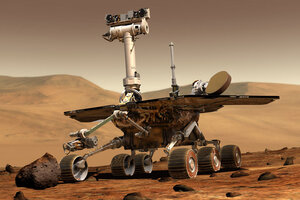NASA's Opportunity rover shatters expectations with 12 years on Mars
When the rover Opportunity landed on Mars in 2004, it was supposed to last for three months. But twelves years later, Opportunity is still exceeding expectations.

NASA released this artist's rendering of NASA rover Opportunity on the surface of Mars. Opportunity landed on the red planet on Jan. 24, 2004 and is still exploring. Its twin Spirit stopped communicating in 2010.
NASA/AP/File
When NASA scientists landed Opportunity on Mars on Jan. 24, 2004, they expected the rover to last for three months.
Opportunity has far outlived its life expectancy, still going strong twelve years later.
And keeping Opportunity alive and moving hasn’t been easy for NASA scientists. Opportunity’s batteries are powered by its own solar panels, an elusive energy source during dark and windy winters.
“Cleaning events have become a critical, yet unplanned component of long-duration solar powered missions on the Martian surface,” explains Discovery News. The rovers’ drivers on Earth optimize windstorms to clean the dusty panels. “Opportunity’s most recent cleaning event occurred toward the end of 2015, before it plunged into Martian winter, thus allowing the rover to continue its valuable work into 2016.”
“Opportunity has stayed very active this winter, in part because the solar arrays have been much cleaner than in the past few winters,” adds Mars Exploration Rover Project Manager John Callas, of NASA’s Jet Propulsion Laboratory in California.
But even when the solar panels are clear of dust, the planet’s long winter solstice brings additional energy struggles. Because Mars is farther from the sun, winters on the red planet last about twice as long as Earth’s winters.
To keep the rover powered up, scientists have to make sure Opportunity’s solar panels are angled towards the sun during the few light hours. These maintenance requirements mean occasionally directing Opportunity towards to more windy and sunny areas of the planet.
“The benefits of dust-clearing events and the strategy of choosing winter locations on north-facing slopes are two key factors in extending Opportunity’s productive career 48 times longer, so far, than the originally planned mission of three months after landing,” NASA said in a press release Monday.
While Opportunity’s mere lifespan is noteworthy, the rover is also impressing NASA scientists with its performance and productivity.
Opportunity’s solar panels are generating more than 460 watt-hours per day this winter, producing enough energy for active operations like rock-grinding. This is far better than Opportunity’s first winter on Mars twelve years ago, when power generation went below 300 watt-hours and NASA scientists couldn’t drive the rover for over four months.
And the rover has broken other records as well.
Opportunity has traveled 26.5 miles on Mars, farther than any other robot on any planet in space. The five wheeled space vehicles trailing Opportunity in distance-traveled were all located on the moon, not Mars. Lunokhuod 2 is in second place, traveling 24.2 miles on the moon in 1973, and Apollo 17 Lunar Rover is in third place with 22.2 miles traveled on the moon a year earlier in 1972.
“With healthy power levels, we are looking forward to completing the work in Marathon Valley this year and continuing onward with Opportunity,” said Dr. Callas.
Opportunity has been exploring the 14-mile-wide crater named Endeavour since 2011. This winter the rover is moving through “Marathon Valley,” in the center of the crater, where NASA scientists suspect clay minerals and water-conducive conditions.
Opportunity landed on Mars with its twin rover, Spirit, in 2004. Spirit also exceeded its life expectancy, but it stopped responding to Earth in 2010 and was declared dead in 2011.

